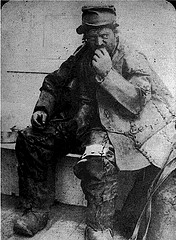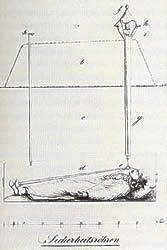
This ain’t quite a mystery, but it ain’t normal either. “The Leather Man” traveled in a 365-mile circuit through Connecticut and southern New York between 1858 and 1889. Everything he wore, from hat to shoes, was hand-made of leather.
The strange vagabond orbited through 32 New England towns, stopping at each at intervals of a little more than a month. That would mean he covered 10 miles a day, on average. He slept in rock shelters and caves, building fires to keep warm, and would accept food from local townspeople, often eating on their doorsteps.
His origins and identity are unknown. It’s said that he was fluent in French, but he communicated mostly in grunts and broken English and would abruptly stop a conversation if asked about his past. He had money, and he wasn’t crazy — the Humane Society detained him briefly in 1888, but they had to let him go, declaring him “sane except for an emotional affliction.” In the end, it’s possible he chose this life.







